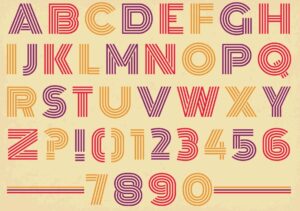Flyers, Posters & Lightshows: The Visual Language of Disco
Before a single beat dropped on the dancefloor, the visual language of disco had already begun to speak. It whispered from nightclub flyers, screamed from neon posters, and exploded across mirrored ceilings in kaleidoscopic light. While disco is remembered for its sound and rhythm, its visual language, crafted through design, light, and space, was equally essential in defining the experience.
In the mid-1970s, as club culture flourished, so too did the visual identity of nightlife. Flyers and posters became critical tools for branding venues and building anticipation. They weren’t just announcements, they were invitations to a parallel universe where rules dissolved and identities were reborn. At iconic clubs like Studio 54 in New York, the Blitz Club in London, and Le Palace in Paris, promotional materials reflected the mystique, glamour, and excess of the nights that awaited.
These designs were bold and eclectic, often featuring surreal typography, cosmic themes, erotic undertones, and shimmering color palettes. Printed on metallic paper or silk-screened in neon inks, these pieces became collectible artifacts. Artists and graphic designersso, me anonymous, some legendary, understood that the flyer was not just ephemera; it was a promise. Just seeing it pinned on a record store wall or handed out on the street created a sense of belonging before even entering the club.

Disco Retro Style Alphabet Set; Source: carterart@vecteezy.com
Once inside, the visual storytelling continued. The disco ball, perhaps the most enduring icon of the era, transformed every ceiling into a starfield. But beyond the mirrored sphere, there were strobe lights, fog machines, and early laser technology that turned dancefloors into sensory playgrounds. Clubs like Paradise Garage employed light-jockeys whose job was as critical as that of the DJ: they choreographed beams and pulses to match the rise and fall of the music.
These lightshows weren’t arbitrary; they were part of a narrative. A track would build slowly, lights dimmed, only to erupt in a synchronized burst of color and sparkle as the beat dropped. It was performance art, guided by instinct and electricity. The lighting rigs in clubs became increasingly sophisticated, often custom-built to fill every inch of space with dynamic energy. In this way, disco anticipated the immersive installations of today’s art and rave scenes.
Visual identity also extended to club interiors – walls lined with chrome or velvet, futuristic sculptures, lighted floors, and installations that blurred the line between architecture and hallucination. Studio 54 famously lowered a giant moon with a spoonful of cocaine at midnight. Le Palace in Paris used fog curtains and light tunnels. These design choices weren’t just ornamental; they shaped the memory of the night.
Even today, flyers from the disco era are studied in design schools, and disco lighting continues to inspire everything from fashion shows to immersive art exhibitions. The aesthetic pioneered during this golden age laid the foundation for how we visualize nightlife, from Ibiza’s megaclubs to Berlin’s underground.
And in the digital age, this tradition continues. Online event banners, Instagram teasers, and LED screen visuals in clubs all owe a debt to the original disco designers. What began as ink and spotlight has become pixels and projection mapping – but the goal remains the same: to seduce, to enchant, and to promise transcendence on the dancefloor.
In the end, disco’s visual legacy is inseparable from its musical one. The two danced in tandem – one you heard, the other you saw. And together, they made you believe in magic.
CONTINUE EXPLORING THE CULTURAL INFLUENCE AND LEGACY OF DISCO:
• Clubbing Culture & Studio 54
• Disco Style: Fashion, Glamour & Identity
• The Art of the DJ: Turntables as Cultural Icons
• Disco in Film and Television: From “Thank God It’s Friday” to “Pose”
• From New York to the World: Disco’s Global Cultural Spread
• Disco Style: Fashion, Glamour & Identity
SOUND REFLECTIONS:
A few key tracks that not only defined the disco era sonically but also inspired the vibrant visual aesthetics of the time, reflected in iconic flyers, posters, and mesmerizing lightshows:
-
-
“Stars” – Sylvester (1979)
Lyrics full of cosmic imagery – stars, shining lights – perfect match for laser shows. -
“Neon Lights” – Kraftwerk (1978)
The ultimate neon-themed disco/kraut track — hypnotic, visual, iconic. -
“Love in C Minor” – Cerrone (1976)
Sensual, long-format track, often used with erotic or psychedelic light projections. -
“Star Wars Theme / Cantina Band” – Meco (1977)
A disco adaptation of the Star Wars soundtrack. Hugely popular on the dancefloor, this track was almost always paired with sci-fi visuals and laser effects. -
“Rocket” – Herbie Hancock (1983)
A post-disco, electro-funk classic. Robotic choreography, neon visuals, and futuristic aesthetics made this track a staple of visually immersive performances. -
“Cosmic Girl” – Jamiroquai (1996)
Though released in the 90s, this track became a cosmic disco favorite. Its playful lyrics and funky beat often inspired colorful, galaxy-themed visual backdrops. -
These tracks not only shaped the sound of disco but also played a pivotal role in defining its visual culture, leaving an indelible mark on the aesthetics of nightlife.
Full Spotify playlist: TOP 500 ESSENTIAL DISCO CLASSICS (1972-1979)
-
